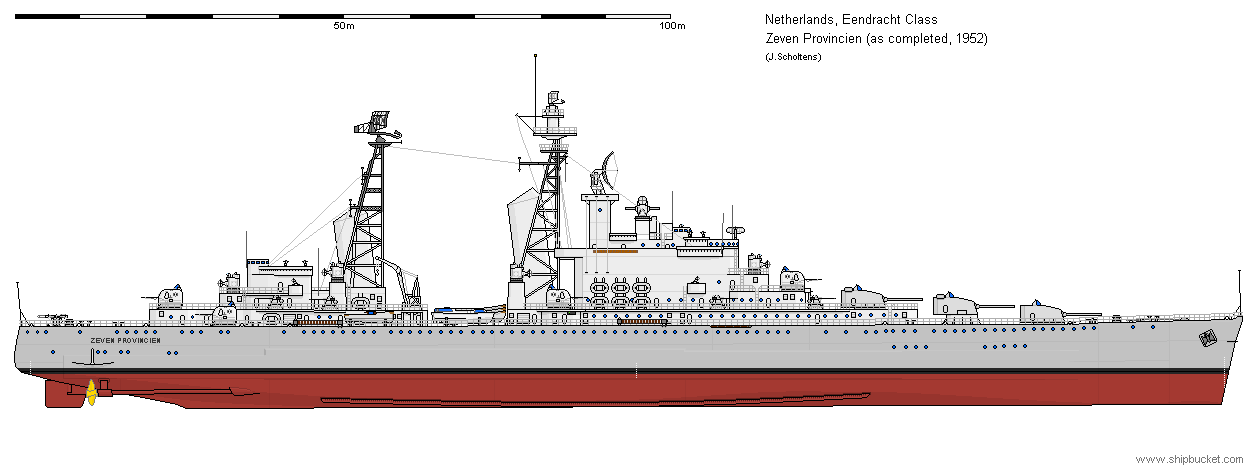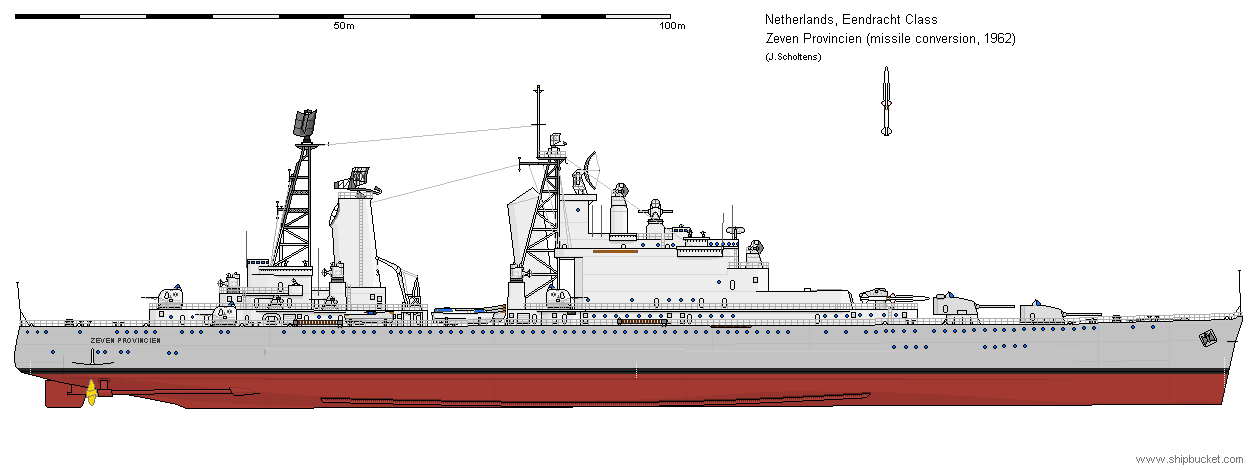Single Ended Eendracht
in 1937, just after the cruiser De Ruyter was commissioned in the Dutch navy, the design work started on the Eendracht class cruisers. these cruisers were meant to replace the Java and Sumatra, 2 world war 1 era cruisers serving mainly in the east indies. the most likely opponent would be the Japanese navy, which had strength in numbers and firepower both. However, from the point of view of the Dutch they had a few big disadvantages: the Dutch would not stand alone in a battle against the Japanese. Powerful allies Britain and the USA would tackle the battleships and most of the heavy cruisers, allowing the Dutch to fight ships of relatively equal strength. Another disadvantage was that the Japanese would fight a long way from home, while the Dutch knew the territory and had ground based planes available.
All this created the strategy that lead to the design of these ships. The hull was based on the recent De Ruyter, however all that was on it was changed. The boilers were positioned aft of the turbine rooms, while the arnament was concentrated forward in 3 triple 150mm gun turrets, build by bofors. In addition, the centrally guided anti-aircraft battery of the De Ruyter (5*twin bofors 40mm #3) was complemented by a second, smaller battery on top of the pilothouse (with 3 of these same mountings) the 2 sets of 3 torpedo tubes were centrally guided and allowed the ship to attack opponents armoured against its guns, while the fully flush deck design added a lot of volume that could be used for flagship tasks.

Well, you guessed right, made up up nearly all of the above for the sake of this design experiment. I wanted to see how well a ship on (nearly) the same hull would work if I gave her an all forward armament. Compared to the real life Eendracht class I lost one gun, but the weight gained by losing one turret gave me the power to expand armour, torpedo protection and the AA battery. Note that each of the turrets has the same firepower as the De Ruyter had on the full forward battery.
Armament consists of: 3*3 150 mm/53 Bofors M39 8*2 40mm/60 Bofors #3 2*3 533mm Torpedo Tubes While this ship cannot cover its own ass, when attacking an invading fleet and it’s escort it can most likely throw a mighty blow. On most ranges all of the forward turrets can open fire on all angles except 45 degrees from the centreline aft. We do not know if this ship would make a difference in the battle of the Java Sea (against Japanese torpedo’s, her additional protection would be the only advantage compared to the De Ruyter) but we do know that, like her real world counterpart, the German invasion would make sure she would not be finished to be there anyways. Instead, she would be finished post-war as the Zeven Provincien cruiser……. Something I hope to add to this thread later on.
A few last things to add here: Note the kingfisher aircraft on the deck. The Netherlands ordered these for use on the ships in the east indies, but after the Java Sea battle there was no fleet to put them on. As planned, they might have ended up on these though, so I added them. Do note the 40mm #3 bofors mountings on the deck. These are basically the stabilised mounting that became known as the hazemeyer, after the on mount radar guidance was added (that was the #4). Expect those to be drawn sometime near ;) as the old hazemeyer drawing was a tad oversized and…… old. 99% of this ship was new drawn, as I disagreed with some parts of alex’s drawing, sometimes the parts were just old or they were just not how I would draw them myself. So just the question here to not copy-paste parts of this vessel for your own use unless you absolutely know what you are doing.
As with the real life version of this ship, the ships were not finished in 1940, when the Germans invaded the netherlands. Some work was done on them by the germans but nothing significant. This resulted in the Netherlands having 2 modern cruiser hulls finished up to main deck level.
These hulls got major modifications to bring them up to postwar standard. Most notably were the adaption of unitised machinery and the addition of radar and fire control systems. in 1952 and 1953 respectively the 2 new ships were completed: the Zeven Provinciën and the De Ruyter. These were modern ships and while they had not the main gun firepower of the original design nor that of foreign cruisers, they were a valuable warship in both ASuW and AAW combat situations.
their armament consists of: 3*2 152mm/53 Bofors M42 6*2 57mm/60 Bofors M50 8*1 40mm/60 Bofors #6 1*1 103mm Bofors Lichtraketwerper
in the postwar years, the threat on the Dutch fleet changed. supersonic anti-ship missiles could no longer be repelled by the AA fit as fitted on board the cruisers, so an new anti-air weapon system was required. the USA made a deal with the Dutch: the Mk 10 GMLS and the missiles would be paid by the US government, but the modifications done to the ships were to be paid by the RNLN. The Zeven Provinciën was first in line to get this new weapon system. cuts on defence spending, higher then expected costs of the reconstruction and the costs of an new maritime patrol aircraft made that no money was available for the second cruiser to be converted.
her armament consists of: 1*Mk 10 Mod 1 GMLS for RIM-2C Terrier Missiles 2*2 152mm/53 Bofors M42 5*2 57mm/60 Bofors M50 4*1 40mm/60 Bofors #6

